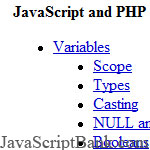









 Cet article énumère JavaScript certaines comparaisons entre deux langages de programmation web les plus populaires dans le monde de l'open source: JavaScript et PHP. Variables, Objet et Array, Structure de contrôle s; dans cette liste, les programmeurs web (les programmeurs) jetez un oeil à leur sujet plus précis et donner les solutions mai appropriative pour les besoins de leurs missions.
Cet article énumère JavaScript certaines comparaisons entre deux langages de programmation web les plus populaires dans le monde de l'open source: JavaScript et PHP. Variables, Objet et Array, Structure de contrôle s; dans cette liste, les programmeurs web (les programmeurs) jetez un oeil à leur sujet plus précis et donner les solutions mai appropriative pour les besoins de leurs missions.
In PHP, objects and arrays are two distinctly different things and have different syntaxes. In JavaScript, objects and arrays are often interchangeable, and you can switch between syntaxes freely.
There are a few different ways to declare an object or an array in both JavaScript and PHP. The key difference between PHP and JavaScript is that JavaScript does not have associative arrays. Arrays in JavaScript are always numeric based. However, since objects may use array-like syntax, simply declare a new object when you'd use an associative array in PHP.
PHP
<?php
// Define an array.
$foo = array(); // New empty array.
$foo = array('a', 'b', 'c'); // Numeric index.
$foo = array('a' => '1', 'a' => '2', 'c' => '3'); // Associative.
// Define an object.
$bar = new stdClass(); // New empty object.
$bar->a = '1';
$bar->b = '2';
$bar->c = '3';
?>JavaScript
// Define an array (longhand).
var foo = new Array(); // New empty array.
var foo = new Array('a', 'b', 'c'); // Numeric index.
// Define an array (shorthand, more common).
var foo = []; // New empty array.
var foo = ['a', 'b', 'c']; // Numeric index.
// Define an object.
var bar = {}; // New empty object.
var bar = { // New populated object.
a: '1',
b: '2',
c: '3'
};As you might notice in the last example, declaring an object in JavaScript uses the format commonly known as JSON, which stands for "JavaScript Object Notation". JSON strings having become very popular as a faster alternative to XML, and can be read and created with the PHP functions json_encode() and json_decode().
JavaScript and PHP are very similar in array notation, though they differ more in their object notation. The key difference is that PHP uses an array "->" to reference items within objects, while JavaScript uses the dot ".".
PHP
<?php
$foo = array('a', 'b', 'c'); // New numeric index array.
print $foo[0]; // 'a'
$bar = new stdClass();
$bar->a = '1';
print $bar->a; // '1';
?>JavaScript
var foo = ['a', 'b', 'c']; // New array.
alert(foo[0]); // 'a'
var bar = { a: '1', b: '2', c: '3' }; // New object.
alert(bar.a); // '1'Let's take one more look at defining an object in JavaScript and see how it can be used to compensate for the lack of associative arrays in JavaScript.
PHP
<?php
$bar = array(
'a' => '1',
'b' => '2',
'c' => '3',
);
?>JavaScript
JavaScript doesn't have associative arrays, but defining an object works identically to an associative array in PHP.
var bar = {
a: '1',
b: '2',
c: '3'
};As mentioned earlier, in JavaScript array and object syntaxes can be mixed freely, so this new object can be referenced either as an array or an object.
// Using array syntax, even though this is an object.
alert(bar['a']); // '1'
// Or the standard object property syntax.
alert(bar.b); // '2'If we had a multi-level object, we can even combine the bracket and dot syntaxes.
var bar = {
a: { red: 'my favorite', blue: 'not so bad' },
b: '2',
c: '3'
}
alert(bar.a['red']); // 'my favorite'
alert(bar['a'].blue); // 'not so bad'PHP
<?php
var_dump($foo);
// Or
print_r($foo);
?>JavaScript
console.log(foo); // Prints to Firebug or Safari console.The classic for() construct is supported nearly identically in PHP and JavaScript.
PHP
<?php
for ($n = 0; $n < 10; $n++) {
print $n;
}
?>JavaScript
// Note that variables should always be
// prefixed with "var" to define a local scope.
for (var n = 0; n < 10; n++) {
alert(n);
}PHP's foreach() construct can easily be converted to JavaScript's for().
PHP
<?php
foreach ($array as $key => $value) {
// Do something.
}
?>JavaScript
for (var key in array) {
// There is no "value" directly, but you can get it easily.
var value = array[key];
// Do something.
}Wrap up
There are still a lot of other topics that could be covered (JavaScript
is a language with a lot of tricks), but this should be a good
foundation to work from. Hope you enjoy!